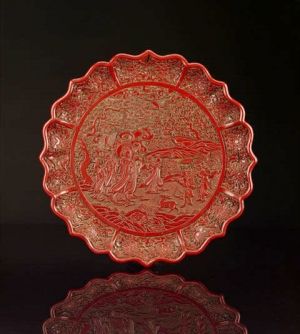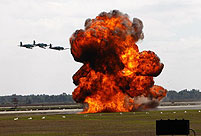 |
| lacquerware (Xinhua) |
Shortcuts don't apply to making quality objects of lacquer, built up carefully in layers. Wang Jie covers the story.
Radiating a serene luster, lacquerware is an exquisite Chinese craft. As the earliest lacquer craftsmen, the Chinese have enjoyed its beauty for centuries. During the past hundred years, it has played an important role in the development of Chinese arts and crafts as well as having a large influence on the world's art.
A red wooden bowl and a red vase unearthed in 1978 at the Hemudu Culture Site of Yuzhao, Zhejiang Province, proved that the Chinese had started to make lacquerware in the Neolithic Age.
Many people, even some young Chinese, mistake lacquerware as something merely covered in red paint. It is, however, a laborious process done by hand.
Ancient Chinese lacquerware was made using a natural lacquer obtained from a type of sumac, a small tree. The sumac needs to be about 10 years old to produce lacquer.
The liquid lacquer should curdle under damp conditions then become firm and resistant to heat, acid and alkali. The manufacturing process is so complex that it makes lacquerware costly.
During the Xia Dynasty (21st-16th century BC) and Warring States Period (476-221 BC), the variety of lacquerware objects made increased. Lacquer was used for furniture, containers, musical instruments and funerary objects.
In the Han Dynasty (206 BC-AD 220), most lacquerware continued to be red or black. It was more widely used, such as for plates, caskets, earrings, crates, board games and other daily necessities or decorative accessories. The craft became more delicate, and included using colorful paint, needle etching and decoration inlaid with gold.
Chinese lacquerware now has become even more delicate, and has acquired some different characteristics in different parts of the country. Those produced in Beijing are marked by their sumptuous style, while Fujian's are light and especially resistant to high temperatures, corrosion and water.
Sichuan's are delicately carved and famous for rubbed patterns. Pieces made in Yangzhou, Jiangsu Province, are known for a unique creative technique, whorl-filling, which uses shells that are made into sheets as thin as cicada wings and pasted carefully onto lacquer objects. During the process, treasures like crystal, jade, pearls and coral also are inlaid into lacquer furniture, tea-ware and calligraphy brushes.
Liu Guobing, a veteran collector, is enamored of the beauty of Chinese lacquer art.

 Annual airshow kicks off in Houston
Annual airshow kicks off in Houston U.S. Navy Carrier Strike Group stages military exercises
U.S. Navy Carrier Strike Group stages military exercises Volkswagen showcases new energy vehicles in Beijing
Volkswagen showcases new energy vehicles in Beijing  How should we get married nowadays?
How should we get married nowadays?  Commentary:
Commentary: Jakie Chan sees Rubber Duck off in Beijing
Jakie Chan sees Rubber Duck off in Beijing Hello! Horror Halloween Celebration!
Hello! Horror Halloween Celebration!  The catwalk to the world of fashion
The catwalk to the world of fashion  Cruise trip to Taiwan
Cruise trip to Taiwan  Unveil PLA air force base
Unveil PLA air force base  Say goodbye to tube-like apartment building
Say goodbye to tube-like apartment building Oriental education or western education?
Oriental education or western education? China in autumn: Kingdom of red and golden
China in autumn: Kingdom of red and golden National Geographic Traveler Photo Contest
National Geographic Traveler Photo Contest Chinese screen goddesses from Beijing Film Academy
Chinese screen goddesses from Beijing Film Academy Day|Week|Month